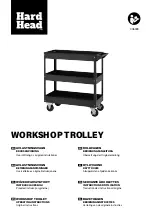
31
Trampolin
Accident risks / Safety tips / Working out
POOR MAINTENANCE OF THE
TRAMPOLINE:
If the trampoline is in poor condition, this
increases the risk of injury. Please check
the trampoline before every use for bent
steel tubes, wear and tear on the bounce
mat, loose or broken springs, and the
stability of the trampoline overall.
WEATHER CONDITIONS:
Please observe weather conditions when
using the trampoline. If the trampoline is
moist or damp, the jumper can slip and
become injured. A strong wind can cause
a loss of control.
SAFETY TIPS TO REDUCE INJURIES
THE JUMPER‘S ROLL IN PREVENTING
ACCIDENTS:
Control of jumps: Don‘t do any difficult,
complicated maneuvers until you have
mastered simple, basic jumps. Gain a
knowledge of the most important rules
and tips: learn all safety tips and warnin-
gs, and take them to heart before using
the trampoline. In a controlled jump, you
land on the same spot where you jumped
from.
THE TRAINER‘S ROLL IN PREVENTING
ACCIDENTS:
A trainer should know and implement
all safety tips and guidelines. It is the
responsibility of the trainer to convey
professional tips and instructions to all
jumpers on the trampoline. If training is
unavailable or inadequate, the trampo-
line must be stored in a safe place and
dismantled to prevent unauthorized use.
It should then be covered with a heavy
tarpaulin which is to be secured with
locks and chains. The trainer is likewise
responsible to see that the safety labels
are posted on the trampoline and that
jumpers are informed about these war-
nings and notices.
WORKING OUT WITH THE TRAMPOLINE
The following exercises are intended to
teach basic steps and jumps before one
continues with more difficult and com-
plicated jumps. Before stepping onto the
trampoline and using it, all safety tips must
be read and understood. Body techniques
and guidelines for using the trampoline
must be fully discussed between professor
and student.
LESSON 1:
1. Getting on and off – performance of the
proper techniques.
2. Basic jump (stretching jump) –
performance and practice.
3. Braking (see jumps) – performance and
practice.
4. Learning braking and control.
5.
Hand and knee – performance and
practice. The focus should be placed on
landing on all fours and its coordination.
LESSON 2:
1. Testing and practice of the techniques
of lesson 1.
2. Knee jump – performace and practice.
First learn simply to bend the knee and
to straighten it out again before comple-
ting a half-turn to the right or the left.
3. Sitting jump – performance and practice.
First learn the simple sitting jump, then
add a knee jump, and fiually a hand and
knee jump.
Trampoline
Heruntergeladen von
Handbücher-Suchmachiene





































